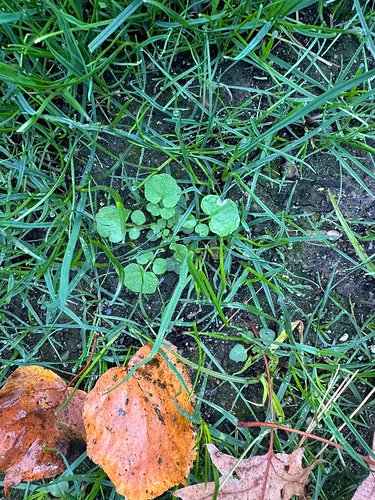I finished a full renovation last month, but now weeds are growing in the bare spots, as you can see in the picture. What type of weed is this, and how can I get rid of it?
- Hairy Bittercress
- Hairy Bittercress
- Hairy Bittercress
- Hairy Bittercress
- Not Hairy Bittercress
- Hairy Bittercress
- Hairy Bittercress
- Hairy Bittercress
- Hairy Bittercress
- Not Hairy Bittercress
I love Reddit.
That, my friend, is hairy bittercress. It is a winter annual, so it’s not on the same cycle as most other weeds. Germinates in the fall and will be growing through winter and drop/explode seeds in the spring. It is not hard to kill with chemicals, but timing is everything. Any pre-emergent will work in the fall; however, only mesotrione can be used when seeding.
Some solutions:
- Start using Preen or something similar in the garden beds. I find it often starts there.
- Mow with a catcher in the spring early before flowers and seeds form!
- You can pull it out easily in the spring in spots you can’t get sprays and a mower.
- Use a starter fertilizer with mesotrione and seed in spring and late summer.
- Apply Prodiamine or Dimension in spring and late summer (works best with 3+ month protection but does not play well with grass seed).
- Spraying mesotrione only has about 2 weeks of pre-emergent protection, so you will still need Prodiamine or something else for both spring and fall to prevent this without getting crabgrass; then seeding is tough to fit in the schedule.
@Paris
Thank you. My grass is new, from seed (Lesco sun & shade). Temps are starting to get in the upper 30s. What can I use now that doesn’t affect the new grass?
Davin said:
@Paris
Thank you. My grass is new, from seed (Lesco sun & shade). Temps are starting to get in the upper 30s. What can I use now that doesn’t affect the new grass?
I wouldn’t spray any weed killers until after you cut the baby grass twice (about 6 weeks), which will probably leave you in the spring. That said, I would do the following:
- Apply Preen to all garden beds every 2-3 months all year round.
- Mow early with the catcher maybe once in March and again in April to catch the weeds hopefully before it goes to seed, but catch the seeds if any. This weed dies on its own once it gets hot, but grows exploding seed pods beforehand.
- Do a Prodiamine pre-emergent in early/mid April.
- Spray broadleaf weeds end of April/early May once they are growing fast.
- Second fertilizer with Dimension if available, or Prodiamine again. Dimension first week in June or Prodiamine end of May; heavy to prevent crabgrass, etc., through summer.
- In July, use fertilizer with bifenthrin like Allectus to kill/prevent grubs on the new fresh soil.
- In early September, the hairy bittercress will try to return from seed. At this time, it’s important to get a pre-emergent down again before it starts to grow. If you miss the window or have any broadleaf weeds like clover, you should spray a 3-way herbicide once the summer heat breaks, as well as the pre-emergent. I would use a fertilizer with Prodiamine at a heavy rate, and this is where you break the cycle of hairy bittercress returning each fall.
I don’t know, but it reminds me of the creeping charlie in my backyard and now I’m mad.
Valen said:
I don’t know, but it reminds me of the creeping charlie in my backyard and now I’m mad.
I second this. It comes in from the neighbor’s yard; I spray the fence line with Roundup monthly and it still pokes through. Between that, the bent grass, and the Poa…

Teo said:
[deleted]
Incorrect, and triclopyr is kind of excessive even if you were right… that is Hairy Bittercress. Either way, a simple 3-way would be better, or anything with 2,4-D, dicamba, or since he has a new lawn, mesotrione may be a better option. Triclopyr is harsh stuff.
@Paris
Triclopyr is expensive stuff, but it’s not harsh… Unless you use triclopyr ester in high temps… which is more about the volatility of esters rather than the actual herbicide.
Ironically enough, triclopyr is actually known and used to be a safener for some desirable grasses. For example, tank mixing triclopyr with Tenacity will reduce the whitening effect and temporary injury for desirable grasses (grasses that are already safe to use Tenacity on). There’s a ton more examples, but yeah, triclopyr is probably the strangest herbicide.
@Dakota
Correct me if I’m wrong, but isn’t this the stuff that is in Crossbow? I’ve heard it makes you permanently blind if you get it in your eyes. The same stuff they use on railroads, poison ivy, and brush killers and remains in soil for a very long time.
@Paris
Oh, that’s what you meant by harsh.
Talking about the safety of individual pesticides is a tricky subject with a lot of nuance that is best left up to regulatory bodies. As much as the public has a habit of mistrusting them, they do know what they’re doing… At least more so than anyone else does.
There is nothing, to my knowledge, that shows triclopyr to be significantly different, one way or another, in terms of human and environmental safety than most other herbicides.
What I can say is, it’s not classified as a carcinogen. I don’t think there are many herbicides that wouldn’t cause blindness if exposed to eyes; it’s moderately persistent in soil (far from the most persistent), and quite toxic to fish and amphibians.
The warnings and restrictions on labels are wisely designed to minimize the individual risks associated with each pesticide.
Kinda looks like ground ivy.
Vic said:
Kinda looks like ground ivy.
Incorrect… Hairy Bittercress.
